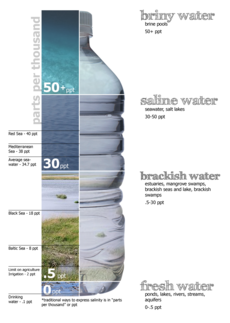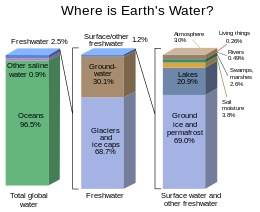Fresh water
This section needs additional citations for verification. (November 2022) |
Fresh water or freshwater is any naturally occurring liquid or frozen
Water is critical to the survival of all living organisms. Many organisms can thrive on salt water, but the great majority of vascular plants and most insects, amphibians, reptiles, mammals and birds need fresh water to survive.
Fresh water is not always potable water, that is, water safe to drink by humans. Much of the earth's fresh water (on the surface and groundwater) is to a substantial degree unsuitable for human consumption without some treatment. Fresh water can easily become polluted by human activities or due to naturally occurring processes, such as erosion. Fresh water makes up less than 3% of the world's water resources, and just 1% of that is readily available. Just 3% of it is extracted for human consumption. Agriculture uses roughly two thirds of all fresh water extracted from the environment.[1][2][3]
Fresh water is a renewable and variable, but finite
Definitions
| Part of a series on |
| Water salinity |
|---|
 |
| Salinity levels |
|
Fresh water (< 0.05%) Brackish water (0.05–3%) Saline water (3–5%) Brine (> 5% up to 26%–28% max) |
| Bodies of water |
Numerical definition
Fresh water can be defined as water with less than 500
Other sources give higher upper salinity limits for fresh water, e.g. 1,000 ppm[6] or 3,000 ppm.[7]
Systems
Fresh water habitats are classified as either
Sources
The original source of almost all fresh water is
In coastal areas fresh water may contain significant concentrations of salts derived from the sea if windy conditions have lifted drops of seawater into the rain-bearing clouds. This can give rise to elevated concentrations of sodium, chloride, magnesium and sulfate as well as many other compounds in smaller concentrations.
In desert areas, or areas with impoverished or dusty soils, rain-bearing winds can pick up sand and dust and this can be deposited elsewhere in precipitation and causing the freshwater flow to be measurably contaminated both by insoluble solids but also by the soluble components of those soils. Significant quantities of iron may be transported in this way including the well-documented transfer of iron-rich rainfall falling in Brazil derived from sand-storms in the Sahara in north Africa.[8]
In Africa, it was revealed that groundwater controls are complex and do not correspond directly to a single factor. Groundwater showed greater resilience to climate change than expected, and areas with an increasing threshold between 0.34 and 0.39 aridity index exhibited significant sensitivity to climate change. Land-use could affect infiltration and runoff processes. The years of most recharge coincided with the most precipitation anomalies, such as during
Water distribution


Saline water in
Freshwater ecosystems
Water is a critical issue for the survival of all living organisms. Some can use salt water but many organisms including the great majority of higher plants and most mammals must have access to fresh water to live. Some terrestrial mammals, especially desert rodents, appear to survive without drinking, but they do generate water through the metabolism of cereal seeds, and they also have mechanisms to conserve water to the maximum degree.

Challenges
The increase in the world population and the increase in per capita water use puts increasing strains on the finite resources availability of clean fresh water. The response by freshwater ecosystems to a changing climate can be described in terms of three interrelated components: water quality, water quantity or volume, and water timing. A change in one often leads to shifts in the others as well.[21]
Limited resource
Water scarcity (closely related to water stress or water crisis) is the lack of fresh water resources to meet the standard water demand. There are two type of water scarcity namely physical and economic water scarcity.[22]: 560 Physical water scarcity is where there is not enough water to meet all demands, including that needed for ecosystems to function. Arid areas for example Central Asia, West Asia, and North Africa often experience physical water scarcity.[23] Economic water scarcity on the other hand, is the result of lack of investment in infrastructure or technology to draw water from rivers, aquifers, or other water sources. It also results from weak human capacity to meet water demand.[22]: 560 Much of Sub-Saharan Africa experiences economic water scarcity.[24]: 11
There is enough freshwater available globally and averaged over the year to meet demand. As such, water scarcity is caused by a mismatch between when and where people need water, and when and where it is available.Minimum streamflow
An important concern for hydrological ecosystems is securing minimum streamflow, especially preserving and restoring instream water allocations.[30] Fresh water is an important natural resource necessary for the survival of all ecosystems.
Water pollution
Society and culture
Human uses
Uses of water include
Global goals for conservation
The Sustainable Development Goals are a collection of 17 interlinked global goals designed to be a "blueprint to achieve a better and more sustainable future for all".[35] Targets on fresh water conservation are included in SDG 6 (Clean water and sanitation) and SDG 15 (Life on land). For example, Target 6.4 is formulated as "By 2030, substantially increase water-use efficiency across all sectors and ensure sustainable withdrawals and supply of freshwater to address water scarcity and substantially reduce the number of people suffering from water scarcity."[35] Another target, Target 15.1, is: "By 2020, ensure the conservation, restoration and sustainable use of terrestrial and inland freshwater ecosystems and their services, in particular forests, wetlands, mountains and drylands, in line with obligations under international agreements."[35]
See also
- Limnology – Science of inland aquatic ecosystems
- Properties of water – Physical and chemical properties of pure water
Notes
- ^ Each tiny cube[i] (such as the one representing biological water) corresponds to approximately 1400 cubic km of water, with a mass of approximately 1.4 trillion tonnes (235000 times that of the Great Pyramid of Giza or 8 times that of Lake Kariba, arguably the heaviest human-made object).[10]
- ^ Only 3% of the Earth's water is fresh water. Most of it is in icecaps and glaciers (69%) and groundwater (30%), while all lakes, rivers and swamps combined only account for a small fraction (0.3%) of the Earth's total freshwater reserves.[citation needed]
Subnotes
- ^ The entire block comprises 1 million tiny cubes.
References
- ^ "Wastewater resource recovery can fix water insecurity and cut carbon emissions". European Investment Bank. Archived from the original on 29 August 2022. Retrieved 29 August 2022.
- ^ "Competing for Clean Water Has Led to a Crisis". Environment. 26 January 2010. Archived from the original on 19 February 2021. Retrieved 29 August 2022.
- ^ "Freshwater Resources | National Geographic Society". education.nationalgeographic.org. Archived from the original on 26 May 2022. Retrieved 29 August 2022.
- ^ "The Fundamentals of the Water Cycle". www.usgs.gov. Archived from the original on 27 November 2019. Retrieved 17 September 2021.
- ^ "Groundwater Glossary". 27 March 2006. Archived from the original on 28 April 2006. Retrieved 14 May 2006.
- ^ "Freshwater". Glossary of Meteorology. American Meteorological Society. June 2000. Archived from the original on 6 June 2011. Retrieved 27 November 2009.
- ^ "Freshwater". Fishkeeping glossary. Practical Fishkeeping. Archived from the original on 11 May 2006. Retrieved 27 November 2009.
- – via ResearchGate.
- ^ "Global climate change impacts on Sub-Sahara Africa: The case of Nigeria's shorelines", The Impact of Climate Change on Sub-Sahara Africa, Peter Lang, retrieved 19 December 2023
- ^ USGS – Earth's water distribution Archived 29 June 2012 at the Wayback Machine. Ga.water.usgs.gov (11 December 2012). Retrieved on 29 December 2012.
- ^ a b "Natural Quality of Water and Groundwater Contamination", Groundwater Contamination, Volume I, CRC Press, pp. 35–56, 14 April 2000, retrieved 19 December 2023
- ^ Where is Earth's water? Archived 14 December 2013 at the Wayback Machine, United States Geological Survey.
- ^ Physicalgeography.net Archived 26 January 2016 at the Wayback Machine. Physicalgeography.net. Retrieved on 29 December 2012.
- ^ Gleick, Peter; et al. (1996). Stephen H. Schneider (ed.). Encyclopedia of Climate and Weather. Oxford University Press.
- ^ OCLC 46393244.
- ISBN 0-471-74178-7.
- ISBN 1-55963-476-6.
- ISSN 1543-5938.
- JSTOR 25031419.
- ISBN 9780123747945
- ^ The World Bank, 2009 "Water and Climate Change: Understanding the Risks and Making Climate-Smart Investment Decisions". pp. 19–22. Archived from the original on 7 April 2012. Retrieved 24 October 2011.
- ^ a b Caretta, M.A., A. Mukherji, M. Arfanuzzaman, R.A. Betts, A. Gelfan, Y. Hirabayashi, T.K. Lissner, J. Liu, E. Lopez Gunn, R. Morgan, S. Mwanga, and S. Supratid, 2022: Chapter 4: Water. In: Climate Change 2022: Impacts, Adaptation and Vulnerability. Contribution of Working Group II to the Sixth Assessment Report of the Intergovernmental Panel on Climate Change [H.-O. Pörtner, D.C. Roberts, M. Tignor, E.S. Poloczanska, K. Mintenbeck, A. Alegría, M. Craig, S. Langsdorf, S. Löschke, V. Möller, A. Okem, B. Rama (eds.)]. Cambridge University Press, Cambridge, UK and New York, NY, USA, pp. 551–712, doi:10.1017/9781009325844.006.
- .
- ^ IWMI (2007) Water for Food, Water for Life: A Comprehensive Assessment of Water Management in Agriculture. London: Earthscan, and Colombo: International Water Management Institute.
- PMID 26933676.
- PMID 30377623.
- S2CID 37062764.
- PMID 24374780.
- ^ "Water Scarcity. Threats". WWF. 2013. Archived from the original on 21 October 2013. Retrieved 20 October 2013.
- ISBN 978-1-59726-106-7. Archivedfrom the original on 17 March 2022. Retrieved 12 September 2009.
- )
- ISBN 978-0-471-48494-3.
- ^ "Water Pollution". Environmental Health Education Program. Cambridge, MA: Harvard T.H. Chan School of Public Health. 23 July 2013. Archived from the original on 18 September 2021. Retrieved 18 September 2021.
- PMID 17666391.
- ^ a b c United Nations (2017) Resolution adopted by the General Assembly on 6 July 2017, Work of the Statistical Commission pertaining to the 2030 Agenda for Sustainable Development (A/RES/71/313 Archived 23 October 2020 at the Wayback Machine)
External links
- The World Bank's work and publications on water resources
- U.S. Geological Survey Archived 6 August 2012 at the Wayback Machine
- Fresh Water National Geographic Archived 27 November 2016 at the Wayback Machine
